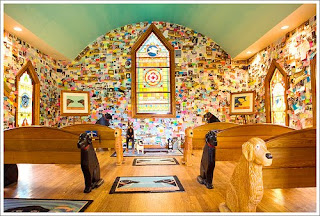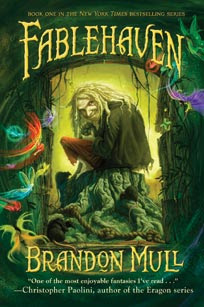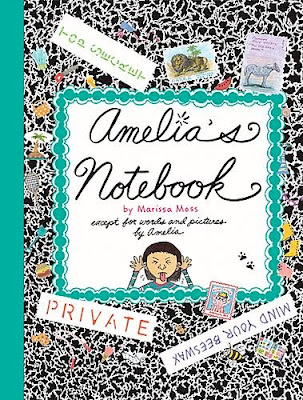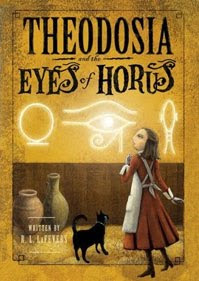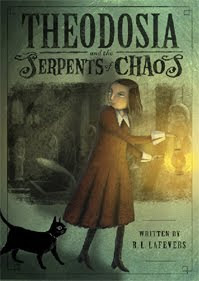
Based on my enthusiasm for
R.L. La Fevers' series
Nathaniel Fludd, Beastologist, I should have known how over the moon I would be about her marvelous creation, eleven year old Theodosia Throckmorton, heroine of
Theodosia and the Serpents of Chaos, book one in the series. Besides being set in 1906, the tail end of one of my favorite historical periods, the Victorian Era, as well as the setting for another magnificent heroine,
Enola Holmes, younger (and superior) sister to Mycroft and Sherlock Holmes, La Fevers dedicates her first book to, "clever girls everywhere who get tired of feeling like no one's listening." Oddly enough, this happened to be the last page of the book that I read after finishing and mulling over the story. La Fevers is very true her dedication throughout the novel: Theodosia is a clever girl to whom no one listens. But, what made me love this book all the more is the way that La Fevers is able to take this all too common situation and bring about a satisfying, believable resolution that both observes and accepts human nature and allows Theo a greater understanding of the adults in her life.
But, I am getting ahead of myself.
Yoko Tanaka provides a rendering of Theo's cat Isis for the heading of each chapter as well as four full page illustrations that are as foggy and sooty as a view through a London window in the winter of 1906 but also eerily illuminating of the story. La Fevers' writing is so rich and detailed that I often found myself wishing for an index of both Victorian and Egyptian terms. I was running to the dictionary to look up "growler," "wadjet eye" (the image of which is used for section breaks within chapters) and "shabti," among many other fascinating words, but maybe this is a good thing for readers to have to do now and again. When we first meet Theo, she is on the trail of Second Assistant Curator Clive Fagenbush at the Museum of Legends and Antiquities, the first being the
British Museum. Theo has always felt ill at ease in the museum and, once she was old enough to read, she learned why. The Egyptian artifacts in the museum, all stolen from tombs, are horribly cursed, some worse than others, and Theo can sense this intensely, although her parents think that she is over sensitive and imaginative, qualities that seem like negatives but will eventually be proven positives. Avoiding boarding school due to the oversight of her distracted Egyptologist parents, Theo spends her days reading the ancient volumes on Egyptian history, religion and magic. Not only has she taught herself how to make amulets and other protective objects from these books, but she has also has an elemental understanding of hieroglyphs and the ability to remove curses from the objects that her mother brings into the museum. This is essential because neither her parents or the other curators in the museum believe that anything is the least bit amiss with any of the artifacts. On top of that, it seems that Theo's father and the others rarely even take notice of her, even during her mother's six-month absence. Despite this, but mostly to make sure she can continue in her studies and curse removals, Theo has become the for her father - feeding him jam sandwiches at tea time and slipping protective amulets into his pockets when he refuses to wear gloves while handling the cursed items.
La Fevers does a wonderful job balancing the necessary plot device of any children's literature that involves adventure - the absent parent(s) - with the actual presence of said parent, a rare occurrence anywhere but the end of the story. Once Theo's mother return from Egypt she has to juggle one adult after another and her rotten little brother, Henry. Not only do the adults in her life ignore her, Henry is outright malicious towards Theo, threatening to ruin her unfettered existence at every turn. When the most important find from the tomb of Thutmose III goes missing, Theo decides to follow the only clue there is, Lord Snowthorpe, curator of the British Museum, who somehow knows that the Heart of Egypt has been found and brought back to London. Hot on the trail, Theo's cover is almost blown by the appearance of Henry, who has been following her all along. After a tenuous alliance, the two continue on the trail only to be joined by Sticky Will, a street urchin that Theo encountered trying to lift her father's wallet at the train station. Because she didn't turn him in to the police, Will has taken o the role of protector to Theo, especially after spotting a shadow figure following her home from the train station.
Theo's hunt leads her, Henry and Will to witness what they believe is a murder. When the attackers flee, the dying man whispers a sting of words to Theo and sends her across the street for help and this is where the adventure really takes off. Theo finds herself in the headquarters of a secret society, The Brotherhood of Chosen Keepers, a group dedicated to fighting the Serpents of Chaos. Wary at first, Lord Wigmere, the leader of the organization, is quickly convinced of Theo's unique talents in both spotting curses and breaking them when, on the very secret Sixth Level, she helps stop a virulent curse that is working it's way up a man's arm. Taken into their confidence, Theo is then given an impossible task. Steal back the Heart of Egypt AND return it to the tomb of Thutmose III before the curse on it brings England to ruin. On top of that, the Brotherhood provides Theo almost no help. But, Theo is nothing if not clever. She manages to convince her parents that they need to return to Egypt immediately to find the Was Scepter that has been left behind in the tomb before the Germans do, stow away on the ship that takes them there, have a bit of a sightseeing trip and make her way back to the tomb with the Heart of Egypt tucked safely in a pouch on a cord around her neck. She even discovers a secret room in the tomb.
None of this seems farfetched in the context of the story, and that is a testament both to La Fevers' writing and the character she has created in Theodosia. As Kate Coombs says of Theo in her review of book three in the series over at
BookAunt, you know that Theo is going to rule something when she is an adult - a corporation, a country, the world - not because "she's bossy or precocious in a sitcom kind of way, but because she knows what she knows and she doesn't suffer fools gladly." However, Theo also loves her parents deeply. When they come to her rescue at the end of the book, after one of the Serpents of Chaos has been trying to convince her that she is a pebble in their shoes and should join them, she realizes that her father's anger was really his own backwards way of expressing his concern for her wellbeing. As he embraces her in a fierce hug, Theo thinks, "in my father's arms, my world was safe and warm again. The adults in my life were back in charge and I'd let them stay there." After a pause, she adds, "For a bit, anyway." Theo and Henry even manage to work out some of their differences and she realizes that his bad behavior towards her was his way of trying to get "my attention this whole time, just like I'd wanted Mother's and Father's." To top it off, Theo even gets a surprise visit from Lord Wigmere, bringing her the gold and lapis ring of the secret society, thus making her an honorary member of the Brotherhood of the Chosen Keepers. Theo is thrilled, but can't stop there and asks Wigmere if she can also get a tattoo of the wadjet eye at the base of her throat like the other members. Shocked, Wigmere refueses and the book ends with the word, "Bother."
One thing I forgot to mention - Theodosia and the Serpents of Chaos is FUNNY. You wouldn't expect it, but La Fevers weaves humor and comic relief throughout the story.
The other two books in the series are Theodosia and the Staff of Osiris and Theodosia and the Eyes of Horus, which is only in hardcover right now. For a great interview with R.L. La Fevers,
visit writer Ellen Oh's website where her daughter, and fan, conducts the
interview.
R.L. La Fevers Nathaniel Fludd series currently has two books in print, the third will be published in October of 2010.

 What are they saying? "Tug-of-war! Tug-of-war, Sally!" When she finally hears this, Sally jumps up and tugs at the rope that is hanging from the balloon. As the warm air escapes, the balloon descends and her ecstatic family and friends welcome her back to earth. Finding the picnic basket full of chicken, they take turns feeding it to her and the book ends with a full tummy and smile for Sally.
What are they saying? "Tug-of-war! Tug-of-war, Sally!" When she finally hears this, Sally jumps up and tugs at the rope that is hanging from the balloon. As the warm air escapes, the balloon descends and her ecstatic family and friends welcome her back to earth. Finding the picnic basket full of chicken, they take turns feeding it to her and the book ends with a full tummy and smile for Sally.




